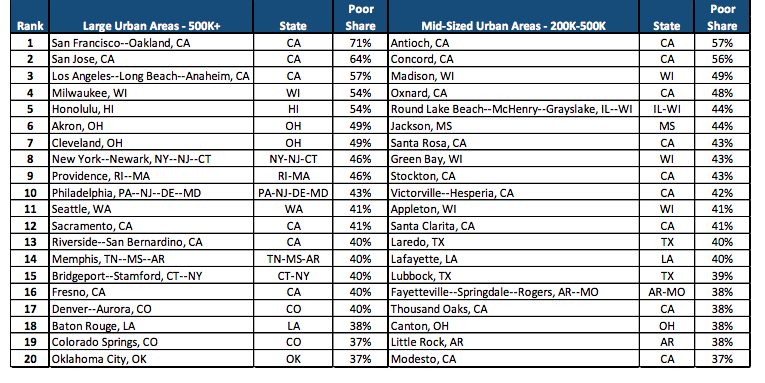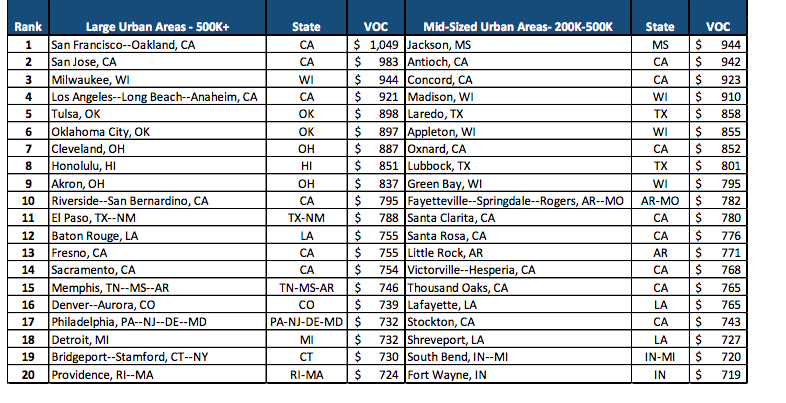TRIP
Executive Summary: Key Facts About Our Nation’s Urban Roads
Keeping the wheel steady on America’s roads and highways has become increasingly challenging as drivers encounter potholes and pavement deterioration. One-third of the nation’s major urban roadways – highways and major streets that are the main routes for commuters and commerce – are in poor condition. These critical links in the nation’s transportation system carry 70 percent of the approximately 3.2 trillion miles driven annually in America. Road conditions could deteriorate even further as the rate of vehicle travel continues to increase and local and state governments find they are unable to adequately fund road repairs.
In this report, TRIP examines the condition of the nation’s major roads, including pavement condition data for America’s most populous urban areas, recent trends in travel, the latest developments in repairing roads and building them to last longer, and the funding levels needed to adequately address America’s deteriorated roadways.
For the purposes of this report, an urban area includes the major city in a region and its neighboring or surrounding suburban areas. Pavement condition data are the latest available and are derived from the Federal Highway Administration’s (FHWA) 2016 annual survey of state transportation officials on the condition of major state and locally maintained roads and highways, based on a uniform pavement rating index. The pavement rating index measures the level of smoothness of pavement surfaces, supplying information on the ride quality provided by road and highway surfaces. Following are the major findings of the TRIP report.
The Nation’s Urban Roads Are Increasingly Deteriorated
One-third (33 percent) of the nation’s major urban roads are rated in poor condition, providing drivers with a rough ride. The charts below detail the top 20 U.S. urban areas with the highest share of major roads in poor condition. The report’s Appendix includes pavement condition data for all U.S. urban areas with a population of 200,000 or more.
Rough Urban Roads Come With High Costs To Drivers
The average motorist in the U.S. is losing $599 annually – a total of $130 billion nationally – in additional vehicle operating costs (VOC) as a result of driving on roads in need of repair. These costs include additional repair costs, accelerated vehicle deterioration and depreciation, increased maintenance costs, and additional fuel consumption. The chart below details the top 20 U.S. urban areas (500,000+ population and 200,000-500,000 population) where motorists pay the highest annual vehicle operating costs as a result of driving on rough roads. The report’s appendix includes VOC data for all urban areas with a population of 200,000 or more.
Travel and Population Growth Are Further Straining Transportation Network
Vehicle travel in the U.S. increased 16 percent from 2000 to 2016, while the nation’s population grew 15 percent from 2000 to 2017. Travel by large commercial trucks increased 29 percent from 2000 to 2016. The additional travel increases the amount of road, highway and bridge investment needed to improve conditions and meet the nation’s transportation needs.
A Significant Boost In Funding Is Needed To Improve Roadway Conditions
The U.S. Department of Transportation’s (USDOT) semi-annual report on the condition, use and funding needs of the nation’s surface transportation program found that the current backlog in needed road and highway rehabilitation is $419.5 billion and that the nation’s current $41 billion annual investment in maintaining the condition of roads and highways should be increased by 33 percent to $61 billion annually to improve the condition of America’s roads and highways.
Transportation Investment Strengthens The Economy
The design, construction and maintenance of transportation infrastructure in the U.S. play a critical role in the nation’s economy, supporting the equivalent of four million full-time jobs across all sectors of the nation’s economy. Approximately 63 million full-time jobs in the U.S. in key industries like tourism, retail sales, agriculture and manufacturing are dependent on the quality, safety and reliability of America’s transportation infrastructure network.
Download full version (PDF): Bumpy Road Ahead
About TRIP
www.tripnet.org
Founded in 1971, TRIP ® of Washington, DC, is a nonprofit organization that researches, evaluates and distributes economic and technical data on surface transportation issues. TRIP is sponsored by insurance companies, equipment manufacturers, distributors and suppliers; businesses involved in highway and transit engineering and construction; labor unions; and organizations concerned with efficient and safe surface transportation.
Tags: FHWA, Pavement, transportation, TRIP, USDOT








 RSS Feed
RSS Feed